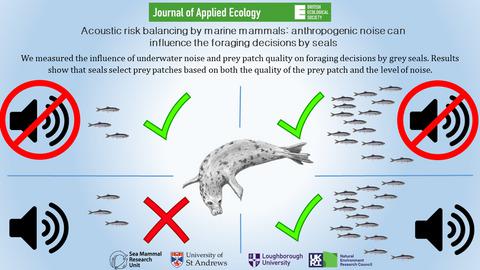当前位置:
X-MOL 学术
›
J. Appl. Ecol.
›
论文详情
Our official English website, www.x-mol.net, welcomes your feedback! (Note: you will need to create a separate account there.)
Acoustic risk balancing by marine mammals: anthropogenic noise can influence the foraging decisions by seals
Journal of Applied Ecology ( IF 5.7 ) Pub Date : 2021-05-22 , DOI: 10.1111/1365-2664.13931 Gordon D. Hastie 1 , Paul Lepper 2 , Chris McKnight 1 , Ryan Milne 1 , Debbie J.F. Russell 1 , David Thompson 1
中文翻译:

海洋哺乳动物的声学风险平衡:人为噪音会影响海豹的觅食决定
更新日期:2021-05-22
Journal of Applied Ecology ( IF 5.7 ) Pub Date : 2021-05-22 , DOI: 10.1111/1365-2664.13931 Gordon D. Hastie 1 , Paul Lepper 2 , Chris McKnight 1 , Ryan Milne 1 , Debbie J.F. Russell 1 , David Thompson 1
Affiliation

|
- Avoidance of anthropogenic sounds has been measured in many species. The results, which are typically based on observations in limited exposure contexts, are frequently used to inform policy and the regulation of industrial activities. However, the occurrence and magnitude of avoidance may be a consequence of complex risk-balancing decisions made by animals. The importance of the factors in decision-making, such as perceived risks associated with the sounds or prey quantity and quality during sound exposure, is unknown.
- Here we address this knowledge gap by measuring the relative influence of perceived –risk of a sound (silence, pile driving, and a tidal turbine) and prey patch quality on decision-making and foraging success in grey seals Halichoerus grypus.
- Seals were given access to two underwater ‘prey patches’ in an experimental pool where fish were delivered at controlled rates to simulate a low-density (LD) and a high-density (HD) prey patch. Acoustic playbacks were made using an underwater speaker above one of the prey patches (randomised during the study), and three decision and foraging metrics (foraging duration, foraging effort allocation between the prey patches, and foraging success) were measured.
- Foraging success was highest during silent controls and was similar regardless of speaker location (LD/HD). Under the tidal turbine and pile-driving treatments, foraging success was similar to the controls when the speaker was located at the HD prey patch but was significantly reduced (~16%–28% lower) when the speaker was located at the LD prey patch. Foraging decisions by the seals were consistent with a risk/profit balancing approach. Avoidance rates depend on the quality of the prey patch as well as the perceived risk.
- Policy implications. The results suggest that foraging context is important when interpreting avoidance behaviour and should be considered when predicting the effects of anthropogenic activities. For example, sound exposure in different prey patch qualities may result in markedly different avoidance behaviour, potentially leading to contrasting predictions of impact in Environmental Assessments. We recommend future studies explicitly consider foraging context, and other contextual factors such as behavioural state (e.g. foraging or travelling) and habitat quality.
中文翻译:

海洋哺乳动物的声学风险平衡:人为噪音会影响海豹的觅食决定
- 已在许多物种中测量到避免人为声音。结果通常基于有限接触环境中的观察结果,经常用于为政策和工业活动监管提供信息。然而,避免的发生和程度可能是动物做出的复杂风险平衡决定的结果。决策中的因素的重要性,例如在声音暴露期间与声音或猎物数量和质量相关的感知风险,是未知的。
- 在这里,我们通过测量声音的感知风险(静音、打桩和潮汐涡轮机)和猎物质量对灰海豹Halichoerus grypus的决策和觅食成功的相对影响来解决这一知识差距。
- 海豹被允许进入实验池中的两个水下“猎物块”,在那里以受控速率运送鱼,以模拟低密度 (LD) 和高密度 (HD) 猎物块。使用水下扬声器在其中一个猎物块上方进行声音回放(在研究期间随机),并测量了三个决策和觅食指标(觅食持续时间、猎物块之间的觅食努力分配和觅食成功)。
- 在静音控制期间觅食成功率最高,并且无论扬声器位置如何(LD / HD)都是相似的。在潮汐涡轮机和打桩处理下,当扬声器位于 HD 猎物区时,觅食成功率与对照组相似,但当扬声器位于 LD 猎物区时,觅食成功率显着降低(降低约 16%–28%) . 海豹的觅食决定与风险/利润平衡方法一致。回避率取决于猎物的质量以及感知的风险。
- 政策影响。结果表明,觅食环境在解释回避行为时很重要,在预测人为活动的影响时应予以考虑。例如,不同猎物质量的声音暴露可能会导致显着不同的回避行为,可能导致环境评估中对影响的预测产生对比。我们建议未来的研究明确考虑觅食环境和其他环境因素,如行为状态(例如觅食或旅行)和栖息地质量。


























 京公网安备 11010802027423号
京公网安备 11010802027423号